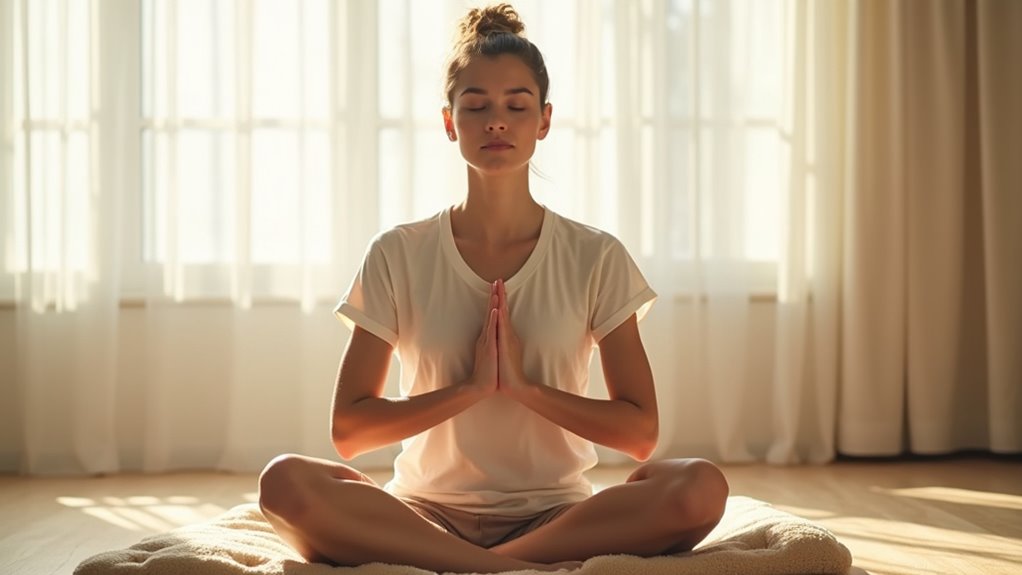When panic attacks strike, you can regain control through scientifically-proven breathing techniques. Start with the 4-7-8 method: inhale through your nose for 4 seconds, hold for 7, and exhale for 8. Practice diaphragmatic breathing by placing one hand on your chest and another below your ribs, focusing on expanding your abdomen while keeping your chest still. Combine these techniques with grounding exercises for maximum effectiveness. Understanding the complete approach to breath control will transform your ability to manage panic attacks.
Understanding the Science Behind Panic and Breathing

While panic attacks can feel overwhelmingly chaotic, they follow clear physiological patterns rooted in the body’s CO2 regulation and fear response systems. When you experience panic, your brain’s fear circuit including the amygdala and prefrontal cortex becomes hyperactive, triggering rapid breathing that reduces CO2 levels by up to 50%. Family history suggests a genetic component may increase your likelihood of experiencing these attacks.
This breathing dysregulation creates a harmful cycle: overbreathing leads to hypocapnia (low CO2), which your brain misinterprets as a threat. Studies show that four-week programs can help patients regain control of their breathing patterns and reduce panic symptoms.
Understanding panic physiology helps explain why breathing regulation is vital. Your shallow, rapid breathing maintains low CO2 levels, causing alkalosis that affects brain chemistry and worsens anxiety.
Irregular breathing patterns during panic attacks create a vicious cycle, as low CO2 levels chemically amplify feelings of anxiety and fear.
The disrupted breathing patterns activate your body’s stress response through the vagus nerve, while impaired breathing regulation prevents your prefrontal cortex from effectively managing fear responses.
The Physical Impact of Deep Breathing on Anxiety

Deep breathing exercises trigger measurable physiological changes that help counter anxiety’s effects on your body. When you practice diaphragmatic breathing, your physiological stress levels decrease through reduced heart rate and skin conductivity. Mouth breathing patterns can increase stress and anxiety levels compared to nasal breathing.
The importance of exhaling first before taking deep breaths helps prevent chest tightness and labored breathing during panic attacks.
Your respiratory regulation improves as you shift from shallow chest breathing to deeper abdominal breathing, helping prevent hyperventilation during panic episodes.
These techniques create positive autonomic responses, particularly when you extend your exhalation time. Research shows increased heart variability measures, especially HF power, indicating better stress resilience.
The long-term effects become more pronounced with consistent practice – studies demonstrate that eight weeks of regular deep breathing training leads to sustained improvements in anxiety management.
Proper technique is essential, as attempting to breathe too forcefully can counteract these benefits.
Mastering the 4-7-8 Breathing Method

Among the most effective breathing techniques for managing panic attacks, the 4-7-8 method stands out for its structured approach and scientific foundation. This pranayama-based technique activates your parasympathetic nervous system, promoting anxiety reduction through controlled breath awareness. Research shows that deep breathing sessions can enhance your motor memory capabilities while calming anxiety. Maintaining proper tongue placement, with your tongue resting against the roof of your mouth, ensures optimal airflow during the exercise.
To master this method, follow these essential steps:
- Inhale quietly through your nose for 4 seconds
- Hold your breath for 7 seconds, maintaining calm focus
- Exhale completely through your mouth for 8 seconds
- Repeat the cycle 2-3 times during each practice session
You’ll achieve peak results by practicing this technique several times daily in a calm environment before needing it during an actual panic attack.
Regular practice helps create neurophysiological shifts in your stress response, making the technique more effective when you need it most.
Diaphragmatic Breathing: A Step-by-Step Guide
Begin your diaphragmatic breathing practice by lying flat on your back with a pillow supporting your head and knees, ensuring your spine remains naturally aligned.
Place your dominant hand on your chest and the other hand just below your rib cage on your abdomen to monitor the correct movement of breath through your diaphragm. You should aim to keep your upper hand motionless while breathing to ensure proper technique.
You’ll find it helpful to set a timer for 5-10 minutes as you track your progress through regular, daily sessions of this powerful breathing technique. As you inhale, focus on expanding your belly while keeping your chest still, followed by a slow exhale through pursed lips for 4 seconds.
Getting Started Right Position
Mastering diaphragmatic breathing starts with finding the right body position to maximize your breathing mechanics.
In comfortable environments, you’ll want to choose ideal seating that supports proper spine alignment and reduces muscle tension. Proper lung expansion occurs naturally when the body is correctly positioned and relaxed. Deep breathing helps reduce anxiety and chest tightness during moments of panic.
Begin with these foundational positions:
- Take a seated position with your feet flat on the floor, placing your hands comfortably on your thighs or lap to maintain spinal alignment.
- If lying down, use a pillow under your knees to release lower back pressure and keep your head slightly raised.
- When standing, position yourself near a wall for support, with your hands resting gently on your hips.
- For reclined practice, confirm your back is fully supported while keeping your knees bent to minimize abdominal tension.
Remember to avoid rigid postures that can restrict your diaphragm’s natural movement and compromise your breathing practice.
Correct Breathing Hand Placement
Now that you’ve established a comfortable position, proper hand placement becomes the next key element in diaphragmatic breathing practice.
Place one hand on your upper chest, just above the rib cage, while positioning your other hand on your abdomen, below the rib cage and above your navel. This dual hand placement creates a direct connection to monitor your breathing patterns.
Keep your hands relaxed without applying pressure they’re there to sense movement, not restrict it. Your hands will help you develop breathing awareness by allowing you to feel the rise and fall of both your chest and abdomen.
This tactile feedback is essential for distinguishing between shallow chest breathing and deeper diaphragmatic breathing. Whether you’re lying down, sitting, or in a reclined position, maintain this hand placement throughout your breathing exercises.
Track Progress With Timer
Setting up a timer marks an essential step in developing effective diaphragmatic breathing habits. Progress tracking becomes more precise when you use timed intervals to measure your breathing practice and improvement. Your timer effectiveness increases as you establish consistent practice routines.
- Begin with 5-minute sessions, using timer beeps to anchor your inhale and exhale phases.
- Count mentally during each breath cycle (1-4 for inhale, 1-4 for exhale) while monitoring your timer.
- Gradually extend your practice duration as you build comfort, increasing from 2-3 minutes to longer sessions.
- Track your daily breath cycles to identify patterns in your panic response and assess your breathing efficiency.
Remember to adjust your timer intervals based on comfort level, starting with shorter 2-3 second counts and increasing as your breathing control improves.
Building a Daily Breathing Practice Routine
A daily breathing practice routine forms the foundation for managing panic attacks effectively when they strike.
You’ll start with brief 5-minute sessions in the morning and evening, gradually building up to longer durations as your comfort level increases.
Keeping a simple log of your practice times and stress levels will help you monitor progress and adjust your routine for best results.
Start Small, Build Consistency
Building a sustainable breathing practice begins with manageable goals that prevent overwhelm and promote long-term success. Start with small sessions of just 5 minutes, focusing on consistent practice rather than lengthy durations. By setting realistic expectations, you’ll establish a foundation for gradual increase while respecting your comfort zones.
- Begin with three to four 5-minute sessions daily, scheduling them around your peak energy levels.
- Use daily reminders and breathing cues tied to routine activities like brushing teeth or morning coffee.
- Increase practice time by 2 minutes each week until reaching 20-30 minutes, adjusting based on your comfort.
- Monitor your response to mindful awareness exercises, pausing if anxiety triggers arise and resuming when calm returns.
This methodical approach guarantees routine integration while building confidence in your breathing practice.
Morning and Evening Sessions
To improve the effectiveness of your breathing practice, establishing consistent morning and evening sessions creates powerful anchors for daily stress management.
Begin your day with morning breathing exercises right after waking, when your cortisol levels naturally peak. These early sessions help prime your nervous system and build resilience against daily stressors.
In the evening, practice your breathing techniques before bedtime to signal your body it’s time to wind down. Evening relaxation through controlled breathing helps establish healthy sleep patterns and reduces nighttime anxiety.
You’ll find the most success by scheduling these sessions during low-stress periods when you can fully focus on your technique. This twice-daily approach strengthens neural pathways associated with calm breathing, making it easier to access these skills when you need them most.
Track Your Progress Daily
Three essential components form the foundation of tracking your breathing practice: consistent daily logging, symptom monitoring, and progress assessment.
Success in managing panic attacks relies heavily on your commitment to maintaining detailed daily logs and progress evaluation.
Track your progression with these key metrics:
- Record your practice duration and note any gradual increases in session length.
- Monitor physical symptoms before and after each session, including heart rate and anxiety levels.
- Document specific triggers that precede panic episodes to optimize your practice timing.
- Rate your post-session relaxation using a 1-10 scale to measure improvement.
Combining Breathing With Other Grounding Strategies
While breathing techniques alone can help manage panic attacks, combining them with grounding strategies creates a more powerful approach for regaining control.
Try integrating diaphragmatic breathing with sensory grounding by focusing on your belly expanding while fixing your gaze on a specific object. The 4-7-8 technique becomes more effective when paired with tactile elements, like holding a cool stone or pressing your feet firmly into the ground.
Combining deep belly breathing with sensory anchors like visual focus points and touch creates a powerful way to calm anxiety and panic.
You can improve your physical presence by coordinating controlled arm movements with each breath cycle.
When practicing structured breathing routines, incorporate the 5-4-3-2-1 method by naming different sensory experiences between breath counts.
If you’re facing breathing challenges, use grounding objects to maintain proper technique – place one hand on your abdomen while holding a textured item in the other.
Frequently Asked Questions
Can Breathing Exercises Make Panic Attacks Worse for Some People?
Yes, you’ll find that breathing exercises can sometimes intensify panic attacks, depending on your personal experiences and sensitivity.
If you’re prone to anxiety, certain techniques might trigger hyperventilation, increase physical tension, or overstimulate your nervous system.
Your individual response can vary based on factors like pre-existing conditions, trauma history, or physical limitations.
It’s crucial to recognize that what works for others may not work for you when managing breathing anxiety.
How Long Should I Practice Breathing Techniques Before Seeing Results?
You’ll typically need several weeks of consistent practice before seeing notable results from breathing techniques.
For ideal benefits, maintain practice sessions of at least 5 minutes, 2-3 times daily. Initial improvements may appear within 2-3 weeks of regular practice, but lasting benefits require 2-3 months of dedication.
Your breathing duration should gradually increase as you build tolerance, and practice consistency is essential – irregular or rushed sessions won’t provide the same benefits.
Should I Continue Regular Medication While Learning Breathing Techniques?
You should absolutely continue your prescribed medication while learning breathing techniques.
The combination of medication benefits and breathing integration creates a thorough treatment approach. Research shows that abruptly stopping medication can disrupt your progress and potentially trigger symptoms.
Work with your healthcare provider to maintain your current treatment while gradually incorporating breathing exercises. This dual approach often yields better results than using either method alone.
Can I Practice Breathing Exercises While Walking or Exercising?
Yes, you can absolutely combine breathing exercises with walking and exercise.
In fact, walking benefits include improved oxygen flow and natural breath regulation. You’ll find that gentle movement supports respiratory control, making it easier to practice breathing techniques.
Start with a slow pace and simple breath patterns, like matching your inhales and exhales to your steps. As you become more comfortable, you can incorporate more advanced exercise techniques.
What if I Feel Lightheaded or Dizzy During Breathing Exercises?
If you feel lightheaded or dizzy during breathing exercises, stop immediately.
Common causes include hyperventilation and CO2 imbalances.
Initially, sit or lie down to stabilize yourself.
Return to normal breathing for 2-5 minutes.
To prevent future episodes, focus on gentle abdominal breathing rather than chest breathing, and start with shorter sessions.
If dizziness persists, try breathing through your nose and extending your exhales slightly longer than your inhales.

